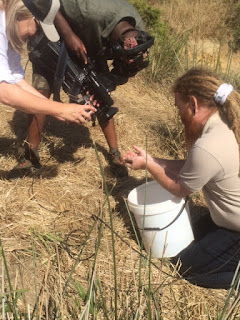We mentioned that 95% of Renosterveld has been converted to cropland. The remaining Renosterveld is fragmented, small (only 10% is larger than 100 hectares), and linked by tiny waterways. Because managing these surviving patches of Renosterveld in isolation would probably lead to further loss, linking corridors between agricultural land and creating awareness of the importance of watercourses has become a very particular focus of the conservation work.
Cameras were set up to survey wildlife moving in the corridor between agricultural land. You’d be amazed at how much life happens in the area around a watercourse between two lands of crops, and how many species depend on the Renosterveld for their existence!
Large grey mongoose, small grey mongoose, water mongoose, yellow mongoose, large-spotted genet, small spotted genet, steenbuck, duiker, meerkat, Cape clawless otter, honeybadger, Aardvark and Aardworf were all among the wildlife captured on camera.
 |
| An Aardvark caught on camera. Looking like something out of a Winnie-the-Pooh story, this solitary and nocturnal animal feeds on termites. Photo used courtesy of Dr Curtis-Scott and the ORTC. |
Landowners can take watercourses (perennial or annual streams, rivers and seepage areas) for granted and not notice erosion, salinisation and invasive alien weeds until late in the day. The ORTC provides farmers with advice and assistance with practical management.




